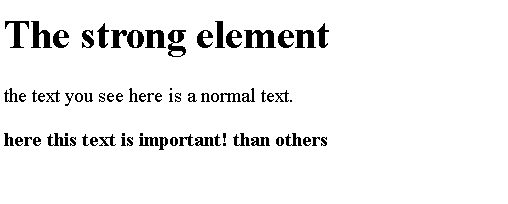HTML <strong> tag
The strong element in HTML is used to display the real significant information in bold so that the user or reader will understand it easily.
Syntax:
<p>
<strong>…………
</strong>
</p>
Example
Here, we will demonstrate how to use the strong HTML element to define essential material of any document:
Example 1:
<!DOCTYPE html>
<html>
<head>
<title> html strong tag </title>
</head>
<body>
<h1>The strong element</h1>
<p> the text you see here is a normal text.</p>
<p>
<strong>here this text is important!than others</strong></p>
</body>
</html>
Output:

You can also use the <b> tag if you want to do the same thing with any specific bold text without any extra importance.
Example 2:
<!DOCTYPE html>
<html>
<head>
<title> html strong tag </title>
</head>
<body>
<h1>The strong element</h1>
<p> in this text you will see some more examples</p>
<p> Before proceeding ahead,
<strong> you should make sure putting on your safety equipments </strong>. </p>
</body>
</html>
Output:

Default CSS Settings
We can also use the <strong> element in the document with the help of default CSS values:
Example:
strong {
font-weight: bold;
}Browser support:
List of browsers that support html <section> tag are mentioned below:
Chrome: yes – version 1 needed
Microsoft edge: yes – version 12 needed
Firefox: yes – version 1 needed
Safari: yes
Opera: yes